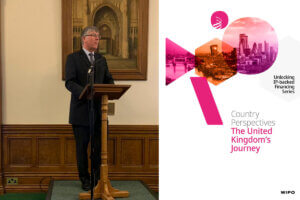Blind assisted technology Blitab and AiPoly
As we venture deeper into the digital age, more technology becomes solely accessible through smart devices. This can cause issues with people who have limited access to these, such as those who are visually impaired. There are a couple of recent innovations emerging that look to greatly improve accessibility to devices and to assist visually impaired persons with independence.
One product that is gaining momentum is Blitab, self-described as “The world’s first tactile tablet for the blind and visually impaired people”. Blitab operates by using liquid-based screen that creates an interactive braille display using small bubbles that can change state. The device will give the user the ability to convert any text file, whether it’s from the internet, a memory card or a USB stick. Although there are been products working towards similar goals, Blitab is an affordable price and uses a unique method to create the braille patterns mirroring the tablet screen content. This invention aims to revolutionize the way that visually impaired people interact with computing devices by offering touch and audio accessibility to add another dimension to the users’ experience.
A further assisted technology AiPoly, is a neural network smartphone application. The software uses artificial intelligence that will understand the camera input and describe what it sees through audio. The app will identify objects and use colour recognition in order to assist both the visually impaired and the colour blind. Currently it can identify products, foods, faces, animals and plants at a speed that reportedly surpasses cloud solutions for image recognition.
AiPoly is available to download, although the creators are still looking to develop the software further to pick up complex scenes, positions of objects and to describe the relationships between items. The aim is for the application to be self-learning and capable of acquiring knowledge on new items to increase its intelligence.
Augmented Reality – Microsoft HoloLens
Microsoft are a company known for continuously experimenting with exciting ideas. Previous examples include Cortana, the windows phone personal assistant, and Illumiroom, a short-lived, conceptual projection system that could expand a television screen onto the room around it. Their next big invention, ‘Microsoft HoloLens’ probes into the world of augmented reality, which is the concept of merging virtual reality and real life. Different to virtual reality, which will encompass the users’ entire vision, augmented reality lets you interact with the environment around you whilst being able to experience virtual elements. The inventor of the HoloLens, Alex Kipman, recently stated in an interview:
There exist two universes today. The universe you and I live in and the digital one made out entirely of bits. Mixed reality is the intersection of both these universes — to suddenly be able to displace space and time without having to deal with all of these digital interfaces that are so unnatural. Without all of this magic being trapped behind a 2D screen
The HoloLens will map out the users’ surroundings and create a holographic frame in the centre of the users’ vision using a custom holographic processing unit in which they can view holograms. This preserves peripheral vision to not obscure the users’ vision or hearing, resulting in a mixed environment that can be specialised for different purposes. There are a wide range of applications for this technology that are still being explored. Up to now, Microsoft have seen the most effective use of the HoloLens is aiding designers in 3D modelling. Other uses that have been hinted include setting up multiple ‘digital’ TV’s around our room and watching 3D sport on a table top. The HoloLens may not be a flawless product yet, but it will certainly provide fertile ground for the expansion of augmented reality.
PowerRay Fishing drone
Created by robotics company PowerVision, the PowerRay aims to remodel the methods used to catch fish. The PowerRay is an underwater drone created to assist the user with fishing and therefore reduce the catching time. Not only can it navigate to depths of up to 30m but also has the technology to lure fish from up to 40m. It does this through using its integrated fish luring light in sequence with a precision remote bait drop. There is also an accompanying smartphone app that will give you information on fish distribution and temperature as well as being able to stream a live HD video. If that isn’t an immersive enough experience for you, it can be connected to a virtual reality headset that will let you see the underwater environment first hand. This drone would be a significant addition for any avid fisherman, however there will likely be speculation into whether this direction of technology would take the effort and experience out of fishing.
Dubai planning to launch passenger drones this summer (2017)
Another drone technology making headlines is an autonomous human-sized quadcopter that Dubai are looking to start rolling out as early as this summer. It has been announced by the head of Dubai’s road and transport agency that the EHANG 184 passenger drone will begin “regular operations” around the city in July of 2017. The eco-friendly, transport concept works by the passenger strapping in and punching in their location, the drone will then take off and fly them to their destination. The passenger drone would then be communicating via a 4g network to a control room from which it is auto-piloted, to guarantee a secure and reliable flight. Additionally, it has the ability to map out the airspace and surrounding areas, to pick out feasible routes and clearest locations to land. The drone can carry passengers up to 100KG and can stay airborne for 30 minutes on one charge. The passenger takes advantage of a touchscreen in order to select a destination and the drone is the “Auto-piloted’ by a command centre. The drone also has the ability to manually determine whether there is enough airspace to be working with. It will map out the surrounding area before finding somewhere to land, looking for the clearest locations before committing.
Testing has already been underway in Dubai, as well in other possible cities such as Nevada with the transport agency ready to put their plans into action as soon as possible. With an autonomous service such as this passenger safety is the number one priority. Akin to the smart self-driving cars and busses that are beginning to arise, the user must be completely reliant on the technology in place. Therefore, the EHANG 184 will likely be rolled out with great caution and emphasis on safety management.







